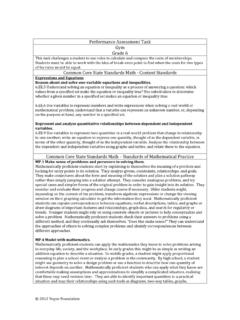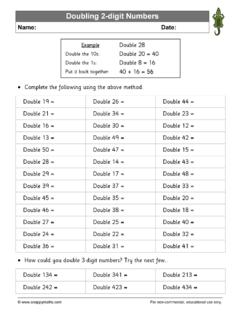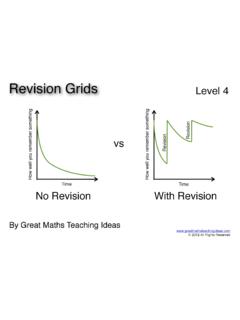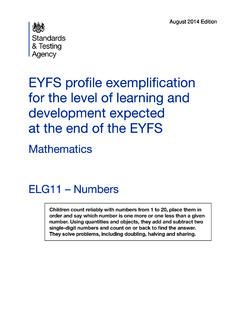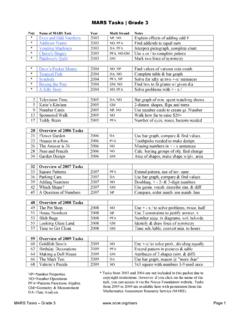Transcription of Performance Assessment Task Adding Numbers Grade 3 …
1 Performance Assessment Task Adding Numbers Grade 3 This task challenges a student to use knowledge of place value to solve a problem using a variety of strategies. The student must demonstrate the ability to make sense of and use someone else's strategy and evaluate the accuracy of the strategy based on calculations and/or understanding and knowledge of place value. A student must be able to calculate accurately using addition, subtraction and multiplication within Grade appropriate parameters. Common Core State Standards Math Content Standards number and Operations in Base Ten Use place value understanding and properties of operations to perform multi digit arithmetic. Fluently add and subtract within 1000 using strategies and algorithms based on place value, properties of operations, and/or the relationship between addition and subtraction. Multiply one digit whole Numbers by multiples of 10 in the range 10 90 ( 9 x 80, 5 x 60) using strategies based on place value and properties of operations.
2 Common Core State Standards Math Standards of Mathematical Practice Construct viable arguments and critique the reasoning of others. Mathematically proficient students understand and use stated assumptions, definitions, and previously established results in constructing arguments. They make conjectures and build a logical progression of statements to explore the truth of their conjectures. They are able to analyze situations by breaking them into cases, and can recognize and use counterexamples. They justify their conclusions, communicate them to others, and respond to the arguments of others. They reason inductively about data, making plausible arguments that take into account the context from which the data arose. Mathematically proficient students are also able to compare the effectiveness of two plausible arguments, distinguish correct logic or reasoning from that which is flawed, and if there is a flaw in an argument explain what it is. Elementary students can construct arguments using concrete referents such as objects, drawings, diagrams, and actions.
3 Such arguments can make sense and be correct, even through they are not generalized or made formal until later grades. Later, students learn to determine domains to which an argument applies. Students at all grades can listen or read the arguments of others, decide whether they make sense, and ask useful questions to clarify or improve the arguments. Look for and make use of structure. Mathematically proficient students try to look closely to discern a pattern or structure. Young students, for example, might notice that three and seven more is the same amount as seven and three more, or they may sort a collection of shapes according to how many sides the shapes have. Later, students will see 7 x 8 equals the well remembered 7 x 5 + 7 x 3, in preparation for learning about the distributive property. In the expression x2 + 9x + 14, older students can see the 14 as 2 x 7 and the 9 as 2 + 7. They recognize the significance of an existing line in a geometric figure and can use the strategy of drawing an auxiliary line for solving problems.
4 They also can step back for an overview and shift perspective. They can see complicated things, such as some algebraic expressions, as single objects or being composed of several objects. For example, they can see 5 3(x y)2 as 5 minus a positive number times a square and use that to realize that its value cannot be more than 5 for any real Numbers x and y. Assessment Results This task was developed by the Mathematics Assessment Resource Service and administered as part of a national, normed math Assessment . For comparison purposes, teachers may be interested in the results of the national Assessment , including the total points possible for the task, the number of core points, and the percent of students that scored at standard on the task. Related materials, including 2012 Noyce Foundation the scoring rubric, student work, and discussions of student understandings and misconceptions on the task, are included in the task packet. Grade Level Year Total Points Core Points % At Standard 3 2007 9 4 58% 2012 Noyce Foundation Adding Numbers This problem gives you the chance to: work with different methods of Adding There are many different ways to add Numbers .
5 Here is one way to add the Numbers 55 and 58. 55. + 58. 113. 1. Below are some different ways of Adding 55 and 58. Most are correct but some are wrong! If you think that a statement is correct, draw a ring around the word Correct. If you think that a statement is wrong draw a ring around the word Wrong. Under each statement show why you think that it is correct or wrong. a. Double 50 then add 8 then add 5. Correct Wrong b. Start with 58 then add 50 then add 5. Correct Wrong Copyright 2007 by Mathematics Assessment 53 Adding Numbers Test 3. Resource Service. All rights reserved. c. Double 58 then subtract 3. Correct Wrong d. Start with 55 then add 60 then subtract 2. Correct Wrong e. Add 5 and 8 then add 100. Correct Wrong f. Add 50 and 60 then subtract 5 and subtract 2. Correct Wrong 9. Copyright 2007 by Mathematics Assessment 54 Adding Numbers Test 3. Resource Service. All rights reserved. Task 3: Adding Numbers Rubric The core elements of Performance required by this task are: section work with different methods of Adding points points Based on these, credit for specific aspects of Performance should be assigned as follows a Rings correct answer: Correct Shows calculation such as: 50 + 50 = 100 100 + 8 + 5 = 113 1.
6 B Rings correct answer: Correct Shows calculation such as: 58 + 50 = 108 108 + 5 = 113 1. c Rings correct answer: Wrong and Shows calculation such as: 55 + 55 = 110 110 + 8 = 118 2. Gives correct answer such as: Only 3 should be added, not 8. d Rings correct answer: Correct Shows calculation such as: 58 + 58 = 116 116 - 3 = 113 1. e Rings correct answer: Correct Shows calculation such as: 55 + 60 = 115 115 - 2 = 113 1. f Rings correct answer: Correct Shows calculation such as: 5 + 8 = 13 13 + 100 = 113 1. g Rings correct answer: Wrong and Shows calculation such as: 50 + 60 = 110 110 - 5 - 2 = 103 2. 9. Total Points 9. Copyright 2007 by Mathematics Assessment 55 Adding Numbers Test 3. Resource Service. All rights reserved. Adding Numbers Work the task and look at the rubric. What do you think are big mathematical ideas being assessed in this task? What does a student need to understand to work these problems? _____. Think about some basic number properties: Equality Property If a = b, then a + c = b +c.
7 Commutative Property In addition, a + b = b + a. While subtraction is not commutative, a subtraction problem can be rewritten as addition to use Commutative Property. For example: 8 2=6. 8 + -2 = 6 and -2 + 8 = 6. Associative Property In addition, (a +b) + c = a + (b + c). By combining these properties with substitution, Numbers can be decomposed to simplify computations. This is what allows the strategies in Adding Numbers to work or not work . A major piece of mathematics is being able to justify or explain why something works, why it is true. At this Grade level, students don't need to have the formal proofs using these properties, but they should have the habit of mind to justify a strategy by showing that it will or will not give an equivalent answer to the original problem. Look at your student work. What percentage of your students did not show any calculations? How do you help establish classrooms norms around justification or explaining their thinking? Are students encouraged to show their work or provide labels on computations?
8 Now think about the different demands of the task. Look at work for b and f, Adding one- and two- digit Numbers . Are students able to align the Numbers and think about place value or are they getting answers like 613, 181, or 230? Now look at student work on doubling: part a, c, and d. How many of your students: Doubling using Doubling using Doubling on only 1 No Doubling addition multiplication or 2 parts Why do you think students may have been confused by this? Why might their thinking be inconsistent? 3rd Grade 2007. Copyright 2007 by Noyce Foundation 56. Resource Service. All rights reserved. While some students have worked with number talks and have a deeper understanding of some of the strategies being presented, all students should be able to read the directions and do the computations. Yet, some students had difficulty with the parts asking for subtraction. Look at student work for part d, e, and g. How many of your students used only addition? Look carefully at the work on part g.
9 How did you students think about the consecutive subtraction? Did they know to break it apart into two steps? Did they attempt to do it as it were column addition? Did they combine the 5+2 first, and then subtract 7? Look at their answers. How many students put: 103 117 104 113 Numbers > Other 120. What might be your next steps to help students think about the consecutive subtractions? How could you set up a task that would confront these misconceptions? How would you manage the discussion? Do students in your class have opportunities to do activities like number talks, where they decompose and recompose Numbers ? How does this help develop their computational fluency? How does this help them to understand the number system, place value, and number properties? Thinking about the student work, what concerned or surprised you about their responses? What might be your next steps in working with them? What might you do differently next year? 3rd Grade 2007. Copyright 2007 by Noyce Foundation 57.
10 Resource Service. All rights reserved. Looking at Student Work on Adding Numbers Student A justifies the answer by giving verbal descriptions and calculations. Although notationally, the student uses 2 subtractions the verbal description shows that the student is thinking about each part separately. Student A. 3rd Grade 2007. Copyright 2007 by Noyce Foundation 58. Resource Service. All rights reserved. Student B seems to look at the directions first and think, How can I get this back to the original Numbers 55+58. For example, look at how the student makes conscious choices about what to do first in problems a, b, and d. Also note that in part g the student chose to write the subtraction as two separate steps. 3rd Grade 2007. Copyright 2007 by Noyce Foundation 59. Resource Service. All rights reserved. Student C is one of the few students who thought about doubling as multiplication. Notice that the student mentally combines the 5 and 2 before performing the subtraction. 3rd Grade 2007.
